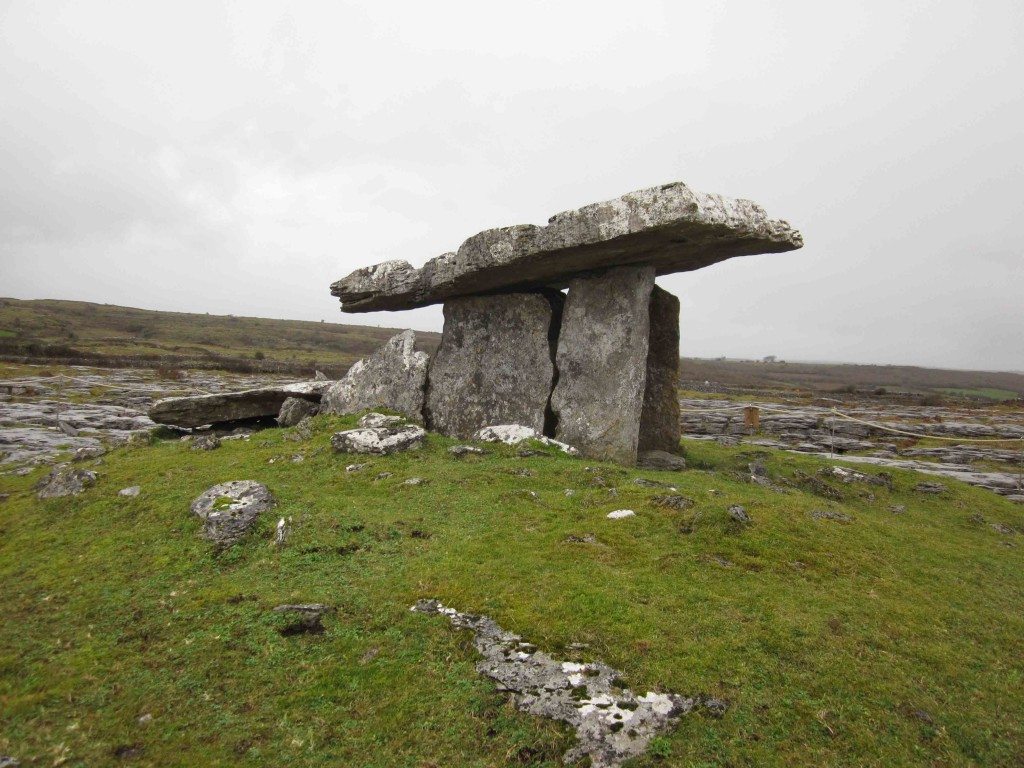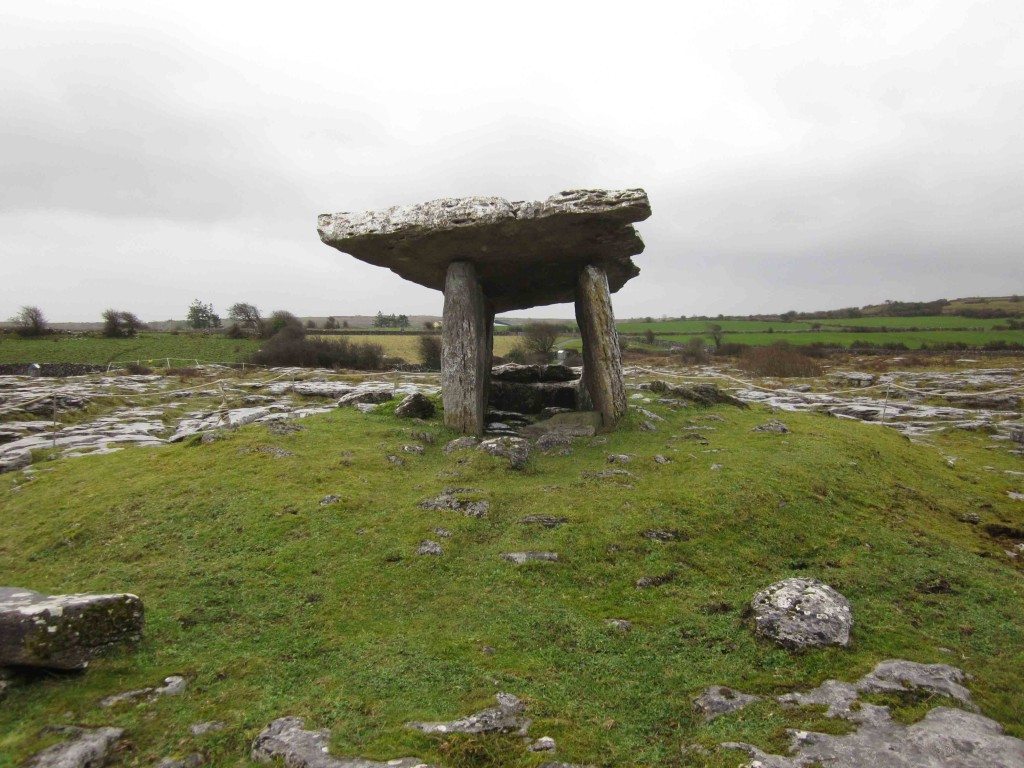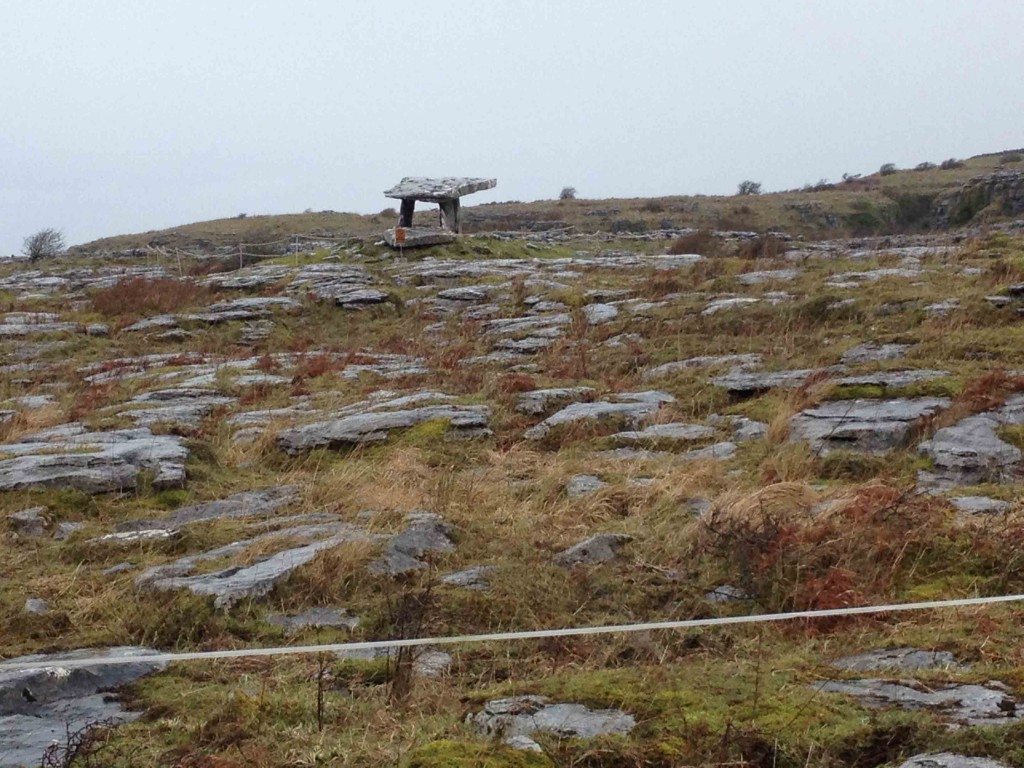Today we have another contribution from Timeless Travels Magazine in which Joshua Mark writes about his visit to Poulnabrone, Ireland.
The Neolithic Age is a quiet time for the history enthusiast. There are no great epics, no legends, not even king’s lists but only the moss covered sites, standing stones, sometimes with enigmatic carvings, and sombre, stone monuments.
These sites do have their stories however, whispered in soft tones, and if one listens carefully one can sense their stories in the presence of the past. Poulnabrone, a dolmen in the region known as the Burren in County Clare, Ireland, is one such site.
In January of 2015 I visited Poulnabrone with my wife, Betsy. It was a cold day with a strong wind coming down from the highlands across the strange, cratered, rock slabs which make up the Burren.
The Neolithic site of Poulnabrone in Country Clare, Ireland, might appear to be just a rock in a field. But to Joshua Mark, it speaks volumes about life 5,000 years ago, even on a cold January day
Poulnabrone was a thirty minute drive from where we were staying at the Churchfield Bed & Breakfast in Doolin and, all along the way, we passed the stray castle or ruins of a stone church or house off in a field or looming suddenly from the hillside. All of these had their stories, such as the ruins of Leamaneh Castle with its tale of the infamous Maire ni Mahon (“Red Mary”) and her many husbands, each of whom seemed to die mysteriously at convenient moments to advance her private goals.

This article was originally published in Timeless Travels magazine. Republished with permission.
We were going to visit a site with no such lively narrative. Neither
of us had ever visited Poulnabrone and when we arrived and Betsy first saw the dolmen from the car park, she said “That’s it? It’s just
a rock out in a field!” I laughed because, of course, she was right.
The photos one commonly sees of Poulnabrone are taken from a low angle and so the dolmen looks like an enormous monument, usually framed by the sky behind it, which one expects to find towering majestically like Stonehenge or the Ring of Brodgar.
In fact, it is quite modest when one visits: roughly 1.8 metres (5.9 feet high) and 3.6 metres (12 feet) long. Even so, it is much more than a rock in a field; it is a 5,000 year old Neolithic monument and, once she was standing before it, Betsy said simply, “It is amazing.”
Poulnabrone is a truly amazing site. It is an exquisite monument of dark stone beautifully constructed and perfectly balanced rising from the pale karst landscape of the Burren. Poulnabrone is a dolmen, a single-chamber, megalithic tomb defined by a capstone resting on upright stones. All of the stones were brought to the site from miles away, none match the geological make up of the Burren, and were then assembled with perfect balance and precision, no concrete, no compounds whatsoever. The immense capstone of Poulnabrone rests on five upright stones: two portal stones, two orthostats (upright stones), and an end stone. Archaeologists who have worked at the site since the first excavations in 1986 have concluded that Poulnabrone is a passage tomb. Once upon a time, it is surmised, the site was erected as a doorway between this world and the next.
If one were to enter the tomb today (which is prohibited as the monument is roped off) one would be standing in the burial chamber which has been measured to 25 cm (9 inches) deep though archaeologists believe it was once 55 cm (21.6 inches) deep. Excavations by archaeologist Ann Lynch in 1986 and 1988 found the remains of 23 people from the Neolithic Age buried in the dolmen: sixteen adults, six children and one newborn. None of the adults lived past the age of forty. Interestingly, the skeletons were clearly placed in the tomb after the bodies had decomposed elsewhere, suggesting to Lynch an elaborate burial ritual in which the body of the deceased had to be taken back by the earth before the bare bones of the deceased could be placed in the portal to the next world. Some of the skeletons showed scorch marks, indicating they had been burned and yet, so unevenly, as to rule out cremation. It is thought these parts of the bodies were burned away to hasten interment in the dolmen, possibly because of the approach of an important festival or rite, though this is only speculation.
In addition to the skeletons, Lynch found a polished stone axe, beads, jewelry, arrowheads, pottery shards and other remains of personal possessions. The capstone of the monument is at an angle and the skeletons of the deceased were placed in the front, at the highest point of the roof, with their possessions. It is thought that the dolmen was so designed to enable the soul to depart easily from the low angle at the back. Although there is no way of knowing for sure, it is possible that the low angle for departure had to do with the ancient Celtic understanding of the Underworld and the monument was specifically tilted in recognition of the Otherworld above the earth and the Underworld below. This Underworld, it should be noted would have had no correlation to the later concept of a `hell’ where souls are punished; it was simply another realm of the Otherworld. These concepts are only known to have arisen later in Celtic culture, as there is no way of knowing what the people who built Poulnabrone believed, but it seems likely, based on excavations and the positioning of the capstone, that those who constructed it believed something along the lines of their descendants.
The site was never `discovered’ as others have been. According to people in the area I spoke with, the site was always known and always recognized as an ancient tomb. No one thought to do anything in particular about it, however, until roughly thirty years ago. Scholars have translated the name `Poulnabrone’ as `Hole of the Quern Stones’, a`quern’ being a stationary stone on which grains were placed to then be ground with a handstone. It has been well established that this was a common practice in Neolithic – and later – times. No one seems to have explained why Poulnabrone, clearly a portal tomb, would be named for its quern stones but perhaps the portal stones and orthostats are the same type which were commonly used as querns.
To the people of the area the site has always been known as the `Hole of Sorrows’. A local man I spoke with at the nearby Birds of Prey and Educational Centre and Aillwee Cave site (highly recommended, by the way) said he had heard of Poulnabrone in connection with quern stones but more frequently as `the place of sorrows’ or `hole of sorrows’. The arrangement of the bodies Ann Lynch discovered in the tomb, as well as the artifacts buried with them, suggests that these were important people to the community – clearly not everyone was allowed to be buried there – and perhaps the loss of these individuals resonated in the grief of their people to give the site its local association with sorrow.
Standing at Poulnabrone and gazing at the monument and the rocks of the Burren behind it is very like stepping back in time. In January, anyway, the road behind us was silent and there were no other visitors that day. The story of the site hung silently in the air and I wished that, through that silence, I could hear something of the tale of who built it and why. Then I understood that the specifics of the `why’ did not really matter. Human beings throughout recorded history have always yearned for an immortal place in the lives of those they leave behind and have always maintained some kind of belief in another world beyond this one. Poulnabrone exemplifies this belief in its very shape and size as it feels like a welcoming shelter in the wilderness where one could find refuge from the elements and rest from one’s chores.
A cold rain began to beat down and the wind picked up sharply. It was time to get going. Looking at the opening of the tomb I could imagine those in the ancient past in this same kind of rain, with the same sorts of hopes and fears and attachments to the earth that I have, passing by Poulnabrone, and seeing a place of safety and a promise of ultimate rest and reunion after this life. Those who built the monument seemed suddenly as close and familiar as my wife standing
next to me.
In season, I was told, tour buses stop at the site regularly and it is a popular attraction with tourists. There is no fee for admission. The site is directly on R476/R480 from Doolin but, from any direction in the area, it is impossible to miss as signs direct one clearly. The car park is small and there are no toilets, no gift shop, and no facilities of any kind. Poulnabrone rises from the rocks of the Burren as it has for thousands of years. It needs no adornment and no attractions other than itself and what it symbolizes. The Neolithic Age is indeed a quiet time but, in the standing stones and monuments left behind, one can feel the same yearnings and hopes one recognizes in one’s self. In viewing this portal to the past I understood how little real difference there was between myself and those who raised the stones of Poulnabrone; and this is finally the most important tale any site can tell – the story of one’s connection to those who have gone before.
About the Author
Joshua Mark is an editor, director, and regular contributor to the online history site Ancient History Encyclopedia. His non-fiction has also appeared in Celtic Guide and his short fiction in Litro, Diddle Dog, Writes for All, and In Between Altered States, among others in print and on-line. He is a part-time professor of philosophy and writing at Marist College, living in upstate New York, USA with his travel companions: his wife, Betsy; daughter Emily; and Sophie, the dog.




